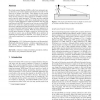Free Online Productivity Tools
i2Speak
i2Symbol
i2OCR
iTex2Img
iWeb2Print
iWeb2Shot
i2Type
iPdf2Split
iPdf2Merge
i2Bopomofo
i2Arabic
i2Style
i2Image
i2PDF
iLatex2Rtf
Sci2ools
106
Voted
APGV
2008
ACM
2008
ACM
HMD calibration and its effects on distance judgments
Most head-mounted displays (HMDs) suffer from substantial optical distortion, and vendor-supplied specifications for field-of-view often are at variance with reality. Such displays do not present perspective-related visual cues in a geometrically correct manner, which has the potential to affect applications of HMDs which depend on precise spatial perception. This paper provides empirical evidence for the degree to which these resulting distortions affect one type of spatial judgment in virtual environments. We show that minification in the HMD that would occur from an overstated HMD field of view results in a significant change in distance judgments. Incorrectly calibrated pitch and pincushion distortion, however, did not cause statistically significant changes in distance judgments for the degree of distortions examined. While the means for determining the optical distortion of display systems are well known, they are often not used in non-see-through HMDs due to problems in measuri...
APGV 2008 | Distance Judgments | Optical Distortion | Substantial Optical Distortion | Visualization |
Related Content
| Added | 12 Oct 2010 |
| Updated | 12 Oct 2010 |
| Type | Conference |
| Year | 2008 |
| Where | APGV |
| Authors | Scott A. Kuhl, William B. Thompson, Sarah H. Creem-Regehr |
Comments (0)

